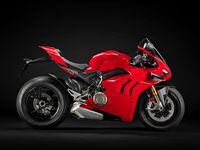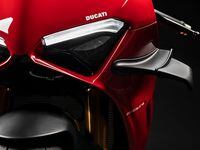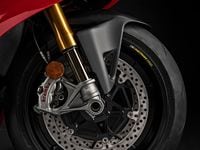Ducati updates the Panigale V4 to consolidate its leading position on the superbike market. In fact, Ducati CEO Claudio Domenicali confirmed that the Panigale V4 was the best-selling superbike in both 2018 and 2019, claiming 18.9 percent of the market, proving the supreme quality of the project and performance potential. The Bologna manufacturer is proudly campaigning its motorcycles in superbike and MotoGP competition, providing a linear transfer of technology to production bikes.
The updated Panigale V4 S is easily identifiable by the addition of aerodynamic winglets to the front fairing, derived from the World Superbike homologation special V4 R. The aero package is claimed to produce 66 pounds of downforce at 168 mph, boosting high-speed stability.
The main aluminum frame retains its basic geometry but receives a number of revisions derived from Ducati’s racing efforts. The flexional rigidity of the aluminum “front frame” has been optimized, the piece now milled on each side. It is said that the changes are aimed at making the Panigale easier to ride and provides increased front-end feel at maximum lean angles.
In addition to main chassis revisions, Ducati has optimized the Öhlins suspension settings. The updated Panigale sees a higher center of gravity and optimized anti-squat effect, resulting in a claimed improved sense of feedback and steering response.
Ducati has recalibrated the ride-by-wire rider-aid system, also derived from the upper-spec V4 R. The Ducati Quick Shift (DQS) and Ducati Traction Control (DTC) now include the EVO 2 strategies, which improves “out-of-corner power control” and shortens shift times at high rpm. Finally, track-dedicated engine mapping also improves power delivery for a more predictable throttle response.



/cloudfront-us-east-1.images.arcpublishing.com/octane/7EUSM4GQEBEFTPAYZ6MOMKMMUQ.jpg)
/cloudfront-us-east-1.images.arcpublishing.com/octane/ZN44KZLHD5CHVIY3WZYAGTPGSI.jpg)
/cloudfront-us-east-1.images.arcpublishing.com/octane/5A776WXBY5GAPDYFTTUEUZNIJA.jpg)
/cloudfront-us-east-1.images.arcpublishing.com/octane/NCYHFQ2S3BAT7EC7VDN2ONGRTU.jpg)
/cloudfront-us-east-1.images.arcpublishing.com/octane/XQORS527YFFT3MVI326EOEYJUI.jpg)
/cloudfront-us-east-1.images.arcpublishing.com/octane/TVDPP3TGMZHODFXASIFUM2KD34.jpg)
/cloudfront-us-east-1.images.arcpublishing.com/octane/EWDMR3DDTBBQPI7DQVZCLMRFAE.jpg)
/cloudfront-us-east-1.images.arcpublishing.com/octane/4XHHLVOUKFE3PDSWNSV4JJMGOE.jpg)
/cloudfront-us-east-1.images.arcpublishing.com/octane/5RLI3NQKQJA3LKKCQHRXQFTL6Q.jpg)
/cloudfront-us-east-1.images.arcpublishing.com/octane/3QCYJCI2RNBENIRWAKEOEKHFUM.jpg)
/cloudfront-us-east-1.images.arcpublishing.com/octane/XJFFFMRN6VEZ7CDNAGKWVPC3H4.jpg)
/cloudfront-us-east-1.images.arcpublishing.com/octane/RMC3CHWSHFAUJA2WJ2FVG4NBOA.jpg)
/cloudfront-us-east-1.images.arcpublishing.com/octane/WXEZV4WAYBERFKSRE5M7GQBW7A.jpg)
/cloudfront-us-east-1.images.arcpublishing.com/octane/LO3PZVGICFGJZBNUA2ORUSAUSE.jpg)
/cloudfront-us-east-1.images.arcpublishing.com/octane/UFHLTNOXLVARVLZV32M6ZJZV4Y.jpg)
/cloudfront-us-east-1.images.arcpublishing.com/octane/CTSWNU7SNNCC3LWB2KATYZ5AXY.jpg)
/cloudfront-us-east-1.images.arcpublishing.com/octane/72EPJVNA2VGVXJ2BVDFFLN67KQ.jpg)
/cloudfront-us-east-1.images.arcpublishing.com/octane/A7C4GNXEHNHC3LL6RETG6MIPPY.jpg)
/cloudfront-us-east-1.images.arcpublishing.com/octane/Q4KZ7ACKF5BVTE56LMG7RPJCEM.jpg)
/cloudfront-us-east-1.images.arcpublishing.com/octane/RQ2CXG6ATJBUZGUR7NP35C3VBE.jpg)
/cloudfront-us-east-1.images.arcpublishing.com/octane/MWSEWNFALBBJHOQGZTUUPVOQOU.jpg)
/cloudfront-us-east-1.images.arcpublishing.com/octane/LTPXG4ZHCVFNDNILFQ6PN6YUKI.jpg)
/cloudfront-us-east-1.images.arcpublishing.com/octane/EAEWHFARGVGHFH4N4BDOSNBJSU.jpg)
/cloudfront-us-east-1.images.arcpublishing.com/octane/AZ7H35TQSZDKZCVM4S6CHERQEU.jpg)